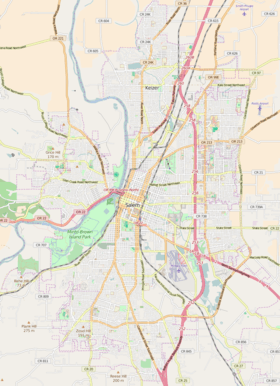Dr. John McLoughlin (sculpture)
 Dr. John McLoughlin Location in Salem, Oregon | |
| Artist |
|
|---|---|
| Year | 1953 |
| Type | Sculpture |
| Medium | Bronze |
| Subject | John McLoughlin |
| Condition | "Treatment needed" (1993) |
| Location | Salem, Oregon, United States |
| 44°56′17″N 123°01′45″W / 44.93804°N 123.02927°WCoordinates: 44°56′17″N 123°01′45″W / 44.93804°N 123.02927°W | |
Dr. John McLoughlin is an outdoor 1953 bronze sculpture of John McLoughlin by Alexander Phimister Proctor and completed by his son Gifford MacGregor Proctor, installed at the Oregon State Capitol grounds in Salem, Oregon, United States. The statue was created by A. Proctor, who died in 1950, and finished by G. Proctor before its dedication in 1953. McLoughlin is depicted wearing a suit and cape, holding a top hat in his left hand. Bedi-Rassy Art Foundry served as the sculpture's founder.
Description and history

Alexander Phimister Proctor's bronze sculpture depicting John McLoughlin is located on the grounds of the Oregon State Capitol in Salem. McLoughlin is shown wearing a suit and cape, with a top hot in his left hand. He has long hair and large sideburns. His left foot is in front of his right, and his right hand extends forward and is clenched in a fist.[1] The statue measures approximately 82 inches (2.1 m) x 42 inches (1.1 m) x 69 inches (1,800 mm) and rests on a concrete base that measures 61.5 inches (1.56 m) x 69 inches (1.8 m) x 81 inches (2.1 m). Its south side includes an inscription that reads: BEDI-RASSY ART FOUNDRY NY. A plaque on the front of the base displays the founder's mark and the text: DR. JOHN MCLOUGHLIN / 1784–1858 / FIRST TO GOVERN / THE OREGON COUNTRY / 1824–1843.[1]
The statue was created during 1950–1953 and dedicated in 1953. According to the Smithsonian Institution, it is a duplicate of another bronze unveiled in the United States Capitol in 1952. This sculpture was financed mainly by legislative appropriation, but also from contributions by Oregon school children. Its model was completed before Proctor's death in 1950. His son and associate Gifford MacGregor Proctor completed the sculpture. The statue was surveyed and considered "treatment needed" by the Smithsonian's "Save Outdoor Sculpture!" program in April 1993, and was administered by the Facility Services department of the State of Oregon at that time.[1]
See also
- 1953 in art
- John McLoughlin Bridge
- Reverend Jason Lee (1953), another sculpture designed by A. Proctor and completed by G. Proctor
References
- 1 2 3 "Dr. John McLoughlin, (sculpture).". Smithsonian Institution. Retrieved April 24, 2015.